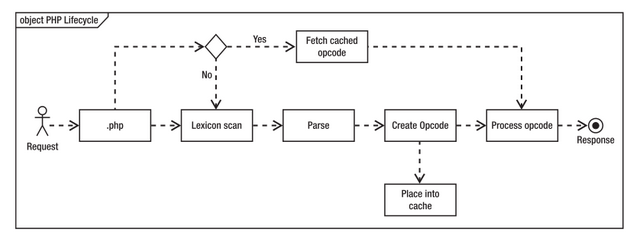php使用blpop时,隔一段时间连接被关闭,做以下检查
- redis.conf 配置 timeout = 0
- php设置配置 default_socket_timeout, 如 ini_set(‘default_socket_timeout’, -1);
php使用blpop时,隔一段时间连接被关闭,做以下检查
根据请求的api获取class, 即需要一个Api class loader, api格式如 xxx.xxx.xx
|
1 2 3 4 5 6 7 8 9 10 11 12 13 14 15 16 17 18 19 20 21 22 23 24 25 26 27 28 29 30 31 32 33 34 35 36 37 38 39 40 41 42 |
/** * @param $api * @param string $oldApi * @return Base * @throws Exception */ function getClass($api, $oldApi = ''){ if(isset(self::$classCaches[$api])){ return self::$classCaches[$api]; } if(!$oldApi){ $oldApi = $api; } if(isset($this->apiMap[$api])){ return new $this->apiMap[$api]; } $path = explode('.', $api); $className = array_pop($path); $apiClass = $this->nsPrefix . ($path ? (implode('\\', $path)) . "\\" : '') . ucfirst($className); if(!class_exists($apiClass)){ if($path){ return $this->getClass(implode('.', $path), $oldApi); }else{ throw new Exception("Invalid api({$api})", Exception::API); } } if($api != $oldApi) $action = str_replace($api . '.', '', $oldApi); else { $action = ''; } /** @var Base $class */ $class = new $apiClass(); $class->setAction($action); self::$classCaches[$api] = $class; return $class; } |
需要一个api 的基类,根据请求参数返回结果
|
1 2 3 4 5 6 7 8 9 10 11 12 13 14 15 16 17 18 19 20 |
public function handle($args, $request = []){ if($this->action){ $method = str_replace('.', '_', $this->action); if($this->action != 'handle' && method_exists($this, $method)){ return call_user_func(array($this, $method), $args); } if(method_exists($this, 'getModel')){ $model = $this->getModel(); if(method_exists($model, $method)){ return call_user_func_array(array($model, $method), $args); } } } else if(method_exists($this, 'execute')){ return call_user_func(array($this, 'execute'), $args); } throw new Exception("Method not found"); } |
弄个js客户端
|
1 2 3 4 5 6 7 8 9 10 11 12 13 14 15 16 17 |
apiUrl : 'http://api.' + location.host + '/index.php?q=%action%&callback=?', api : function(api, args){ if(!args){ args = {}; } var deferred = $.Deferred(); var url = this.apiUrl.replace(/%action%/, api); $.getJSON(url, args, function(response){ if(jc001.papi.is_succ(response)){ deferred.resolve(response.data); } else { deferred.reject(response); } } ); return deferred; } |
|
1 2 3 4 5 |
papi.api('comm.region.name', 2747).done(function(rs){ console.log(rs); }).fail(function(rs){ console.log(rs); }); |
接口文档及web接口测试
加一个接口日志及统计收工
有需要web在线查看对象文档需求,简单测试可行
|
1 2 3 4 5 6 7 8 9 10 11 12 13 14 15 16 17 18 19 20 21 22 23 24 |
function test1(){ $class = new ReflectionClass('TestObject'); //$properties = $class->getProperties(); $methods = $class->getMethods(ReflectionMethod::IS_PUBLIC); foreach($methods as $method){ $doc = $method->getDocComment(); echo "\t" . $doc; echo "\n"; $params = $method->getParameters(); echo implode(' ', Reflection::getModifierNames($method->getModifiers())); echo ' ', $method->getName() . '('; foreach($params as $param){ echo $param->getName(); if($param->isDefaultValueAvailable()){ $value = $param->getDefaultValue(); echo "=", $value; } } echo ")"; echo "\n"; } } |
Reflection
注解反射对象, 获取类方法,属性,类等的注释
常用方法, 返回 Collection, 可遍历的对象集合(Annotation)
|
1 2 |
public getClassAnnotations (); public getMethodsAnnotations (); |
Reflection的使用参考:
|
1 2 3 4 5 6 7 8 9 10 11 12 13 14 15 16 17 18 19 20 21 22 23 |
use Phalcon\Annotations\Adapter\Memory as MemoryAdapter; use Phalcon\Annotations\Reader; use Phalcon\Annotations\Reflection as PhalconReflection; function test2($useCache = 1){ if($useCache == 1) { $reader = new MemoryAdapter(); $reflection = $reader->get('TestObject'); } else { // Parse the annotations in a class $reader = new Reader(); $parsing = $reader->parse('TestObject'); // Create the reflection $reflection = new PhalconReflection($parsing); } // Get the annotations in the class docblock $classAnnotations = $reflection->getClassAnnotations(); var_dump($classAnnotations); $methodAnnotations = $reflection->getMethodsAnnotations(); var_dump($methodAnnotations); } |
Annotation 注解类
获取单个注解的名称、参数表达式等
注解示例
|
1 2 3 4 5 6 7 8 9 10 11 12 13 14 15 16 17 18 19 20 21 22 23 24 25 26 27 28 29 30 31 32 33 34 35 36 37 38 39 40 41 42 43 44 45 46 47 48 49 50 |
<?php /** * Simple Annotation * * @SomeAnnotation */ /** * Annotation with parameters * * @SomeAnnotation("hello", "world", 1, 2, 3, false, true) */ /** * Annotation with named parameters * * @SomeAnnotation(first="hello", second="world", third=1) * @SomeAnnotation(first: "hello", second: "world", third: 1) */ /** * Passing an array * * @SomeAnnotation([1, 2, 3, 4]) * @SomeAnnotation({1, 2, 3, 4}) */ /** * Passing a hash as parameter * * @SomeAnnotation({first=1, second=2, third=3}) * @SomeAnnotation({'first'=1, 'second'=2, 'third'=3}) * @SomeAnnotation({'first': 1, 'second': 2, 'third': 3}) * @SomeAnnotation(['first': 1, 'second': 2, 'third': 3]) */ /** * Nested arrays/hashes * * @SomeAnnotation({"name"="SomeName", "other"={ * "foo1": "bar1", "foo2": "bar2", {1, 2, 3}, * }}) */ /** * Nested Annotations * * @SomeAnnotation(first=@AnotherAnnotation(1, 2, 3)) */ |
doctrine/annotations
https://github.com/doctrine/annotations
http://php.net/manual/zh/book.reflection.php
一直没有时间整理之前的笔记,现在打算每个星期花点时间整理一下,以存根
php程序自身不能正常的执行,根据严重情况分为多种错误等级
递归查找指定类型的文件
|
1 2 3 4 5 6 |
$it1 = new RecursiveDirectoryIterator($path); $files = new RecursiveIteratorIterator($it1); $regexIterator = new RegexIterator($files, '/\.(css|js|html|php|tpl)$/'); foreach ($regexIterator as $fileInfo) { } |
弄个函数
|
1 2 3 4 5 6 7 8 9 |
protected function getFiles($path, $pattern, $recursion = false){ if($recursion){ $it = new RecursiveIteratorIterator(new RecursiveDirectoryIterator($path)); } else { $it = new FilesystemIterator($path); } return new RegexIterator($it, $pattern); } |
在实现正常的TCP/IP 双方通信情况下,是无法伪造来源 IP 的,也就是说,在 TCP/IP 协议中,可以伪造数据包来源 IP ,但这会让发送出去的数据包有去无回,无法实现正常的通信。这就像我们给对方写信时,如果写出错误的发信人地址,而收信人按信封上的发信人地址回信时,原发信人是无法收到回信的。一些DDoS 攻击,如 SYN flood, 就是利用了 TCP/ip 的此缺陷而实现攻击的。对这种行为定义为“发射出去就不管”。
HTTP 是一个应用层协议,基于请求 / 响应模型。客户端(往往是浏览器)请求与服务器端响应一一对应。请求头均以回车换行结束,即“\r\n ” , 最后是一个空行(内容为 \r\n ) , 表示请求 header 结束。而请求 header 中除第一行外,其它行均由 header 名称, header 值组成, 在HTTP 应用程序中,如何取得指定的请求 header 信息呢?这里使用 PHP 语言为例说明。对所有客户端请求 header, PHP 程序中取得其值的方式如下:
$_SERVER[‘HTTP_ HEADER_NAME ‘]
HEADER_NAME应该以换成对应的 header 名称,此项的规律是:全大写,连接线变成下划线。比如要取得客户端的User-Agent 请求头,则使用 $_SERVER[‘HTTP_USER_AGENT’], 掌握这个规律,即可达到举一反三的效果。如要取得 COOKIE 信息,则使用 $_SERVER[‘HTTP_COOKIE’] 即可。也就是说, $_SERVER 数组中,以 HTTP开头的项均属于客户端发出的信息。
为防止http客户端伪造ip, 服务器重新配置X-Forward-For 为正确的值。以nginx为例
……
fastcgi_param HTTP_X_FORWARDED_FOR $remote_addr;
include fastcgi_params;
……
如果网站做了cdn, 或是用作其它代理,那与代理层协商真实ip变量名,以在程序作出相应处理
多台PHP服务器, 为方便管理,使用NFS共享程序文件(用过sersync实现实时同步),在访问量少的情况没啥问题,当php-fpm进程数与访问量上来后,
php-fpm错误日志报告大量执行超时;
系统日志报告大量php-fpm进程段错误或其它错误信息;
php服务器负载变得出奇的高,cpu,mem,io等负载都很低;
在Top中nfs的rpc进程排在前面;
由于单一访问可能加载上百的php程序文件,即使使用xcache缓存了opcode, 但还需要判断文件是否被修改,如下流程所示

如果能减少从网络获取文件信息的大量操作,那此问题就能得到很大程度的解决,opcache很早就知道,只认为是与xcache, apc, ea之类的类似缓存或缓存opcode之类的,当时也就懒得理它,后来仔细查看有我们所期望的参数,在一时间间隔内不判断php文件修改时间
opcache.validate_timestamps(默认值:1)
禁用时, 您必须手动重置Zend Optimizer +或重新启动Web服务器,以使文件系统的更改生效. 检查的频率是由指令 “opcache.revalidate_freq” 控制.opcache.revalidate_freq(默认值:2)
多久(以秒为单位)检查文件时间戳以改变共享内存的分配.”1″ 表示一秒校验一次, 但是是每个请求一次. “0″ 表示总是在校验.
通过ab测试发现qps还有20%左右的提高,最关键的是服务器top中看不到nfs的rpc进程身影,到此问题解决
参考
xcache: http://blog.linuxeye.com/361.html
opcache: http://blog.haohtml.com/archives/14646
wordpress换了一个域名网站无法正常打开
更新数据库配置
update wp_options set option_value = ‘{new_domain}’ where option_id = 1 or option_id = 2;
没有仔细看过代码,不保证不影响相关功能
#grep ‘genericons/genericons.css’ -r ./*
#vim ./wp-content/themes/twentyfifteen/functions.php
注释函数 twentyfifteen_scripts
第一行 wp_enqueue_style( ‘twentyfifteen-fonts’, …);
#grep ‘gravatar.com’ -r ./*
#vim ./wp-includes/link-template.php
注释函数 get_avatar_data 最后一行